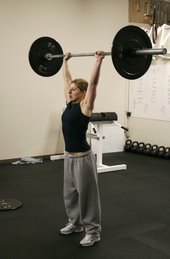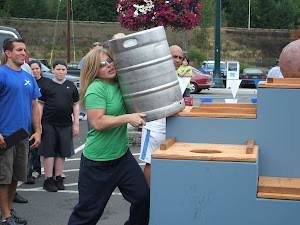I often tell people that my job is to say the same thing every day as if for the first time. At some point I have to trust that it will permeate even the most stubborn brands of denial. There are a few key concepts that will never change about fitness and yet it's those very concepts that make a lot of people push back. Though the conversation is sometimes compelling and it keeps me employed, ultimately weight loss is still a math problem and too much of any one thing will likely break you in some way. True and true.
Here's another catchy remix of one of my favorites, sung to a slightly different tune:
Cutting Back on Endurance Volume May Not Reduce Aerobic Capacity
Traditional endurance training models that emphasize very high volumes and moderate intensities, although practiced by nearly all elite, endurance athletes, are a primary factor in the high rate of chronic overuse injury in endurance sports. Consequently, research has sought alternative methods for optimizing endurance performance while reducing injury. Preliminary studies on high intensity resistance exercise and explosive or plyometric training have been promising.
One concern expressed by endurance athletes, is the effect that replacing endurance training volume with anaerobic training will have on maximal aerobic capacity; a determinant of endurance performance. A recent study published in the International Journal of Sports Medicine may help quell this fear. The researchers determined that max VO2 is unaffected when up to 20% of endurance training volume is replaced by explosive training.
Twenty-five 16-18 year old distance runners participated in the 8-week study. The participants were divided into two groups, one replacing ~20% of total endurance training volume with power/explosive training. Total training volume was equivalent between groups. The researchers completed pre- and post-assessment of top speed during anaerobic running and 30-m speed, top speed of aerobic running, maximal oxygen uptake, running economy, concentric and isometric leg extension, rate of force production in leg extension, and quadriceps size.
The explosive training group experienced small but significant changes in neuromuscular performance and anaerobic measures, including increased rectus femoris size. Increases in lean body mass or muscle hypertrophy is not often found during training of endurance athletes.
Although measures of aerobic performance were not improved, the fact that there was no decline is an important finding. Supplementing endurance training, and reducing endurance volume, by integrating more explosive and resistance exercise may reduce injuries by increasing muscle strength/size, increasing neuromuscular performance and reducing repetitive stress of movement.
Mikkola, J. et al (2007) Concurrent Endurance and Explosive Type Strength Training Improves Neuromuscular and Anaerobic Characteristics in Young Distance Runners. International Journal of Sports Medicine.
skip to main |
skip to sidebar








A conversation with my clients about exercises, work-outs and nutrition
Search This Blog

About Me
- Heather
- I'm an NSCA-PT and CrossFit certified personal trainer with nine years experience. I hold a purple belt in Brazilian Jiu Jitsu under Marcelo Alonso and Ben Blackstone and I am a Karnataka State Gold Medalist in Weightlifting.

Books
Brain Rules: 12 Principles for Surviving and Thriving at Work, Home, and School Food Politics: How the Food Industry Influences Nutrition, and Health, Revised and Expanded Edition (California Studies in Food and Culture)
Food Politics: How the Food Industry Influences Nutrition, and Health, Revised and Expanded Edition (California Studies in Food and Culture) Good Calories, Bad Calories: Fats, Carbs, and the Controversial Science of Diet and Health (Vintage)
Good Calories, Bad Calories: Fats, Carbs, and the Controversial Science of Diet and Health (Vintage) The Omnivore's Dilemma: A Natural History of Four Meals
The Omnivore's Dilemma: A Natural History of Four Meals Practical Programming for Strength Training
Practical Programming for Strength Training PROTEIN POWER
PROTEIN POWER Secrets of the Soil : New Solutions for Restoring Our Planet
Secrets of the Soil : New Solutions for Restoring Our Planet Starting Strength (2nd edition)
Starting Strength (2nd edition) The Brain Trust Program: A Scientifically Based Three-Part Plan to Improve Memory, Elevate Mood, Enhance Attention, Alleviate Migraine and Menopausal Symptoms, and Boost Mental Energy
The Brain Trust Program: A Scientifically Based Three-Part Plan to Improve Memory, Elevate Mood, Enhance Attention, Alleviate Migraine and Menopausal Symptoms, and Boost Mental Energy Fiber Menace: The Truth About the Leading Role of Fiber in Diet Failure, Constipation, Hemorrhoids, Irritable Bowel Syndrome, Ulcerative Colitis, Crohn's Disease, and Colon Cancer
Fiber Menace: The Truth About the Leading Role of Fiber in Diet Failure, Constipation, Hemorrhoids, Irritable Bowel Syndrome, Ulcerative Colitis, Crohn's Disease, and Colon Cancer The Revolution Will Not Be Microwaved: Inside America's Underground Food Movements
The Revolution Will Not Be Microwaved: Inside America's Underground Food Movements The Zone: A Dietary Road Map to Lose Weight Permanently : Reset Your Genetic Code : Prevent Disease : Achieve Maximum Physical Performance
The Zone: A Dietary Road Map to Lose Weight Permanently : Reset Your Genetic Code : Prevent Disease : Achieve Maximum Physical Performance Twinkie, Deconstructed: My Journey to Discover How the Ingredients Found in Processed Foods Are Grown, Mined (Yes, Mined), and Manipulated into What America Eats
Twinkie, Deconstructed: My Journey to Discover How the Ingredients Found in Processed Foods Are Grown, Mined (Yes, Mined), and Manipulated into What America Eats Mind the Gap: The Science Behind the Sporting Mind
Mind the Gap: The Science Behind the Sporting Mind Extraordinary Knowing: Science, Skepticism, and the Inexplicable Powers of the Human Mind
Extraordinary Knowing: Science, Skepticism, and the Inexplicable Powers of the Human Mind The Subtle Body: An Encyclopedia of Your Energetic Anatomy
The Subtle Body: An Encyclopedia of Your Energetic Anatomy Stumbling on Happiness
Stumbling on Happiness
Products


Resources
- Art DeVany
- Brain Health
- Buy Kettlebells
- CrossFit Eastside
- CrossFit Main Page
- Dr. Cordain's Research
- Dr. Eades
- Dr. Ladd Carlston
- Dr. Randip Singh
- Environmental Working Group
- Food, Farming & Healing Arts
- Get Up! Newsletter
- Health Geek's Wikipedia
- Homework for 10a Class
- Jennifer Adler M.S., C.N.
- Marcelo Alonso BJJ
- Michael Pollan
- O'Lifting Coach Mike Burgener
- Predictably Irrational
- Robb Wolf
- TED: Ideas Worth Spreading
- THIS IS THE PREFERRED MEAL TRACKER
- Tim Ferriss, 4 Hour Work Week


